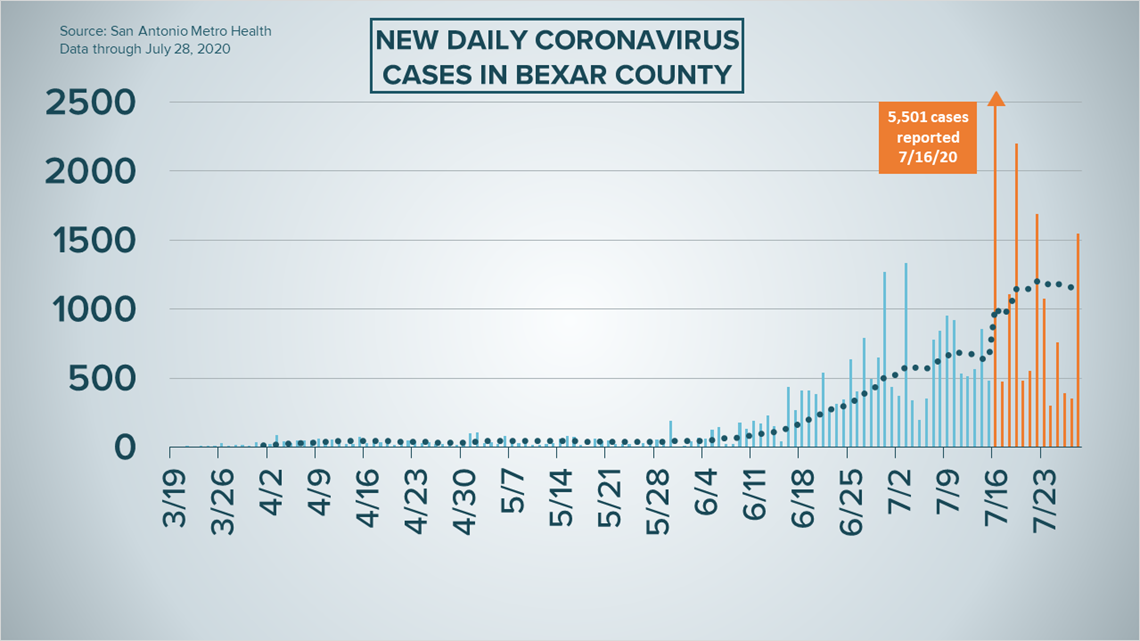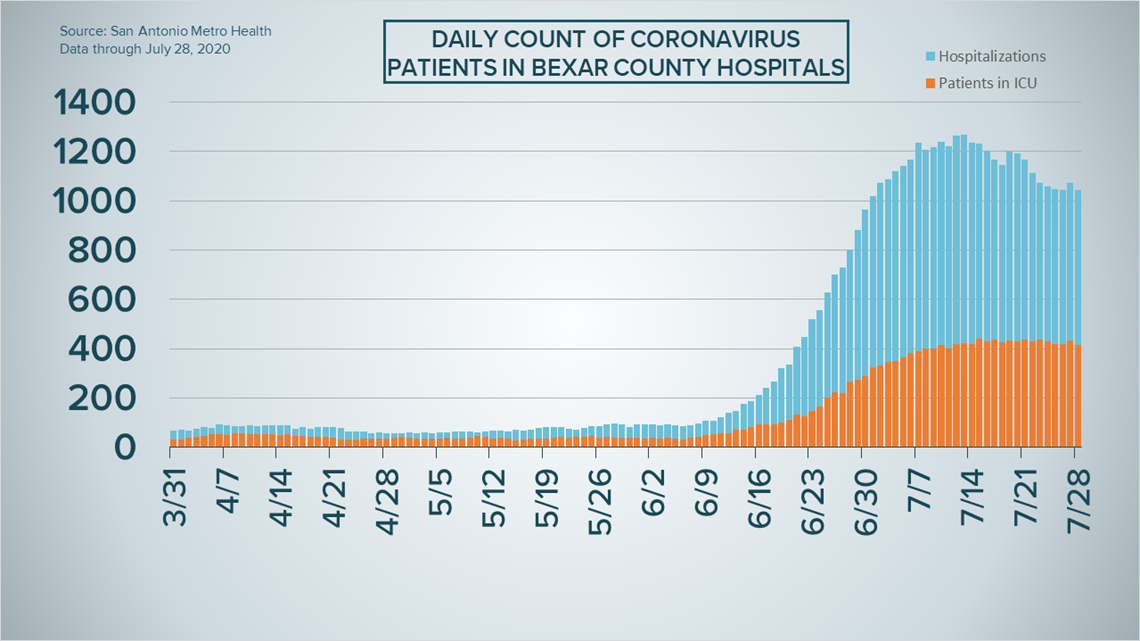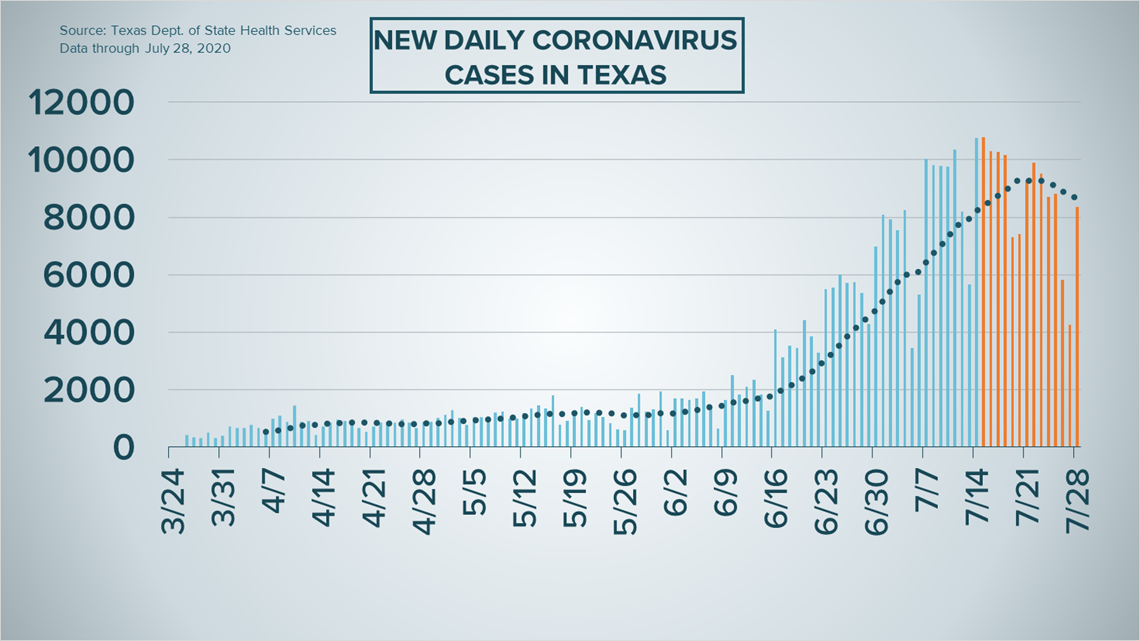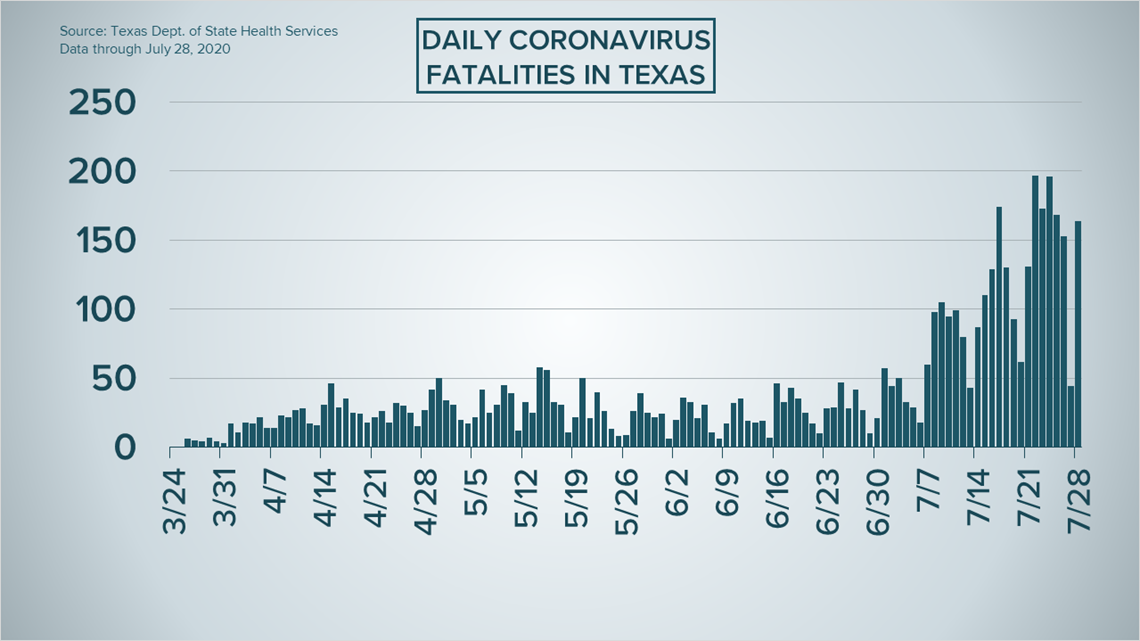SAN ANTONIO — We're tracking the latest numbers from the coronavirus pandemic in San Antonio and across Texas. Here are the latest numbers reported by Bexar and surrounding counties:
- Bexar County: 1,546 new cases and 12 additional fatalities from COVID-19 were reported Tuesday. There have been a total of 37,984 cases as the county death toll rises to 335.
- Comal County: The county reported 88 new cases on Tuesday. There have been a total of 1,602 cases and 45 deaths as of Tuesday evening.
- Hays County: The county reported 42 new cases and no additional virus-related deaths on Tuesday. In all, 4,245 cases of COVID-19 have been confirmed in the county; 2,969 of those cases are considered active. The death toll remains at 25.
How Bexar County is trending
We're tracking how many coronavirus cases are confirmed in Bexar County each day from the time San Antonio Metro Health began reporting cases more than five months ago. Graphing those daily case numbers along a 14-day moving average provides an accurate picture of the curve in the San Antonio area and the direction we're heading amid the coronavirus.
On Tuesday, Mayor Ron Nirenberg reported 1,546 new cases of the novel coronavirus in Bexar County. That represents a surge after 1,486 total cases were reported from Saturday through Monday.
Meanwhile, a day after no new deaths were reported for the first time in nearly a month, Nirenberg on Tuesday said there had been a dozen additional virus-related deaths in the county. The death toll is now up to 335.


After briefly rising on Monday, the number of local hospitalizations decreased on Tuesday. There are 1,045 county residents receiving treatment for COVID-19 in hospitals, while 413 are in intensive care and 283 are on ventilators.


Coronavirus in Texas
State health officials on Tuesday reported an additional 8,341 cases of the coronavirus in the Lone Star State, bring the total to 394,265.




Texas also announced 164 new deaths from virus complications, bringing the death toll in Texas to 5,877. Meanwhile, for the sixth straight day, Texas says it's reporting incomplete hospitalizations data. The Department of State Health Services reported that 9,593 Texans are receiving treatment for COVID-19, but that represents information provided by 91% of hospitals in the state.
The full statement from the department reads as follows:
DSHS is reporting incomplete hospitalization numbers 7/23-7/28 due to a transition in reporting to comply with new federal requirements. For July 28, 91 percent of hospitals reported complete data to DSHS, resulting in a partial data set and the appearance of a drop in hospitalizations. DSHS continues to work with Texas hospitals during this transition to ensure all facilities can fully report the data required.
An estimated 244,449 Texans have recovered, while 143,939 remain ill with the virus.
Coronavirus symptoms
The symptoms of coronavirus can be similar to the flu or a bad cold. Symptoms include fever or chills, cough, shortness of breath or difficulty breathing, fatigue, muscle or body aches, headache, new loss of taste or smell sore throat, congestion or runny nose, nausea or vomiting and diarrhea, according to the Centers for Disease Control.
Most healthy people will have mild symptoms. A study of more than 72,000 patients by the Centers for Disease Control in China showed 80 percent of the cases there were mild.
But infections can cause pneumonia, severe acute respiratory syndrome, kidney failure, and even death, according to the World Health Organization. Older people with underlying health conditions are most at risk.
On June 25, the CDC expanded the list of groups at a higher risk of severe illness due to coronavirus.
Experts determined there was consistent evidence these conditions increase a person's risk, regardless of age:
- Chronic kidney disease
- COPD (chronic obstructive pulmonary disease)
- Obesity (BMI of 30 or higher)
- Immunocompromised state (weakened immune system) from solid organ transplant
- Serious heart conditions, such as heart failure, coronary artery disease, or cardiomyopathies
- Sickle cell disease
- Type 2 diabetes
The CDC believes symptoms may appear anywhere from two to 14 days after being exposed.
Human coronaviruses are usually spread...
- Between people who are in close contact with one another (within about 6 feet).
- Through respiratory droplets produced when an infected person coughs, sneezes or talks. These droplets can land in the mouths or noses of people who are nearby or possibly be inhaled into the lungs.
- Some recent studies have suggested that COVID-19 may be spread by people who are not showing symptoms.
Help stop the spread of coronavirus
- Stay home when you are sick.
- Eat and sleep separately from your family members
- Use different utensils and dishes
- Cover your cough or sneeze with your arm, not your hand.
- If you use a tissue, throw it in the trash.
Lower your risk
- Wash your hands often with soap and water for at least 20 seconds. If soap and water are not available, use an alcohol-based hand sanitizer.
- Avoid touching your eyes, nose, and mouth with unwashed hands.
- Avoid close contact with people who are sick.
- Clean and disinfect frequently touched objects and surfaces.
- The CDC recommends wearing a mask or cloth face covering if you have to be out due to an essential service or essential activity such as going to the grocery store.
- If you are 60 or over and have an underlying health condition such as cardiovascular disease, diabetes or respiratory illnesses like asthma or COPD, the World Health Organization advises you to try to avoid crowds or places where you might interact with people who are sick.

